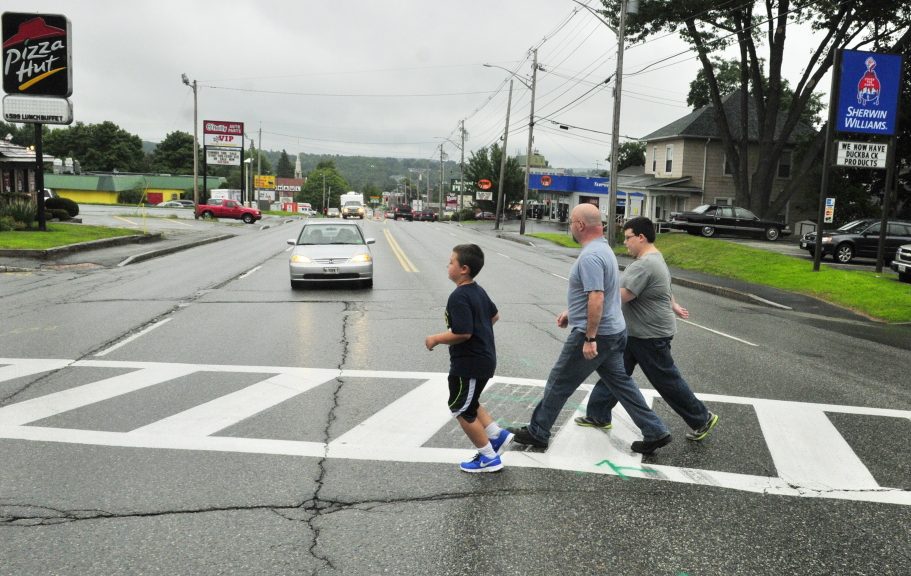AUGUSTA — Both Sherry Belka and Patrick Dunn used the same phrase to describe crossing certain roads in the city: “You’re taking your life in your hands.”
Belka, who is blind, lives off Western Avenue and used to walk across the busy road to her job at the Office of the State Treasurer. She no longer does, out of concern that hurried drivers won’t yield for her.
Dunn lives at the intersection of West River Road and Old Belgrade Road, and he occasionally crosses the intersection to reach Le Club Calumet. But he’s stopped walking his dog across the road, worried about the speed of cars and trucks rumbling through there.
Both Augusta residents were among the almost 50 people who went to Augusta City Center on Wednesday night to take part in a forum about pedestrian safety. The crowd included residents, city officials and police officers.
The goal of the event was to promote safe walking habits and collect information about dangerous locations and behavior that local people have observed. Its organizers, the Maine Department of Transportation and the Bicycle Coalition of Maine, have been holding similar events around the state and hope to use that information to create actionable plans for improving pedestrian safety.
The next forum is scheduled for 6 p.m. Nov. 29 in Hallowell’s City Hall Auditorium.
They’ve embarked on that effort to try to understand and address a recent spike in the number of Mainer pedestrians who are killed by cars each year.
From 2006 to 2013, the number of pedestrians killed in crashes hovered around nine or 11 each year. But that number virtually doubled in 2015, reaching 19, and has remained close to that in the next two years. In 2016, 17 pedestrians died in crashes, and 18 have died so far this year.
“We became concerned in 2015, when it more than doubled,” said Patrick Adams, the state’s bicycle and pedestrian program manager, who helped lead the forum. “We had hoped it was just an anomaly and it would go back down, but we were mistaken.”
There’s no clear explanation for that uptick, and part of the goal of the ongoing project is learn more about it, Adams said. They’ve held forums in communities such as Winslow, Bangor, Bath and Westbrook, which are among the 21 that the state is focusing on. Almost 30 percent of the state’s population lives in those communities, and about 65 percent of the state’s pedestrian accidents happen in them.
The state considers pedestrians to be anyone on foot or in a wheelchair.
While different factions might want to blame crashes on either drivers or on pedestrians, or even on the design of roads, the data actually suggests that all three have contributed in different ways, Adams said.
A factor that is commonly associated with pedestrian traffic deaths is low-light conditions, such as at dusk, dawn or nighttime, and one of lessons imparted to attendees of the Augusta forum is the importance of bright clothing and reflective strips that can make pedestrians more visible at night.
“If you’re wearing a reflective doodad, or reflective clothing, you can be seen 400, 500 feet away,” said Jim Tasse, who works for the Bicycle Coalition of Maine, during a presentation Wednesday night.
Tasse’s group has received a contract from Maine DOT to help with the pedestrian safety project.
Tasse also told attendees that data strongly suggests walking on the left side of the road, toward traffic, is safer than walking with your back to traffic. From 2011 to 2015, 108 pedestrian crashes involved people with their backs to traffic, while just 46 involved those walking toward it, according to Maine DOT.
After Tasse and Adams delivered their presentation Wednesday, they gave residents an opportunity to meet in groups and mark on maps what parts of the city are dangerous for pedestrians.
On one group’s maps, a dotted green line of marker ink stretched the length of Western Avenue. Dunn was in that group and marked the intersection near his home, which he no longer crosses with his dog.
Belka attended the forum, she said, because she hopes the city can “improve its walkability” for people who are blind or have other disabilities. “I’d love to be able to walk to work,” she said.
While Belka recognizes that the resources for making such improvements are limited, she added, “I’d like to see us make at least one big change” to a intersection that pedestrians use, such as building a robust crosswalk with flashing lights.
Going forward, Adams said, the state’s pedestrian safety project will include several components. Besides conducting outreach in the 21 communities, organizers also plan to work with schools and law enforcement groups to promote better pedestrian safety.
Communities will be asked to conduct “pedestrian safety audits,” and pilot projects will be implemented in at-risk communities.
Charles Eichacker — 621-5642
Twitter: @ceichacker
Send questions/comments to the editors.



